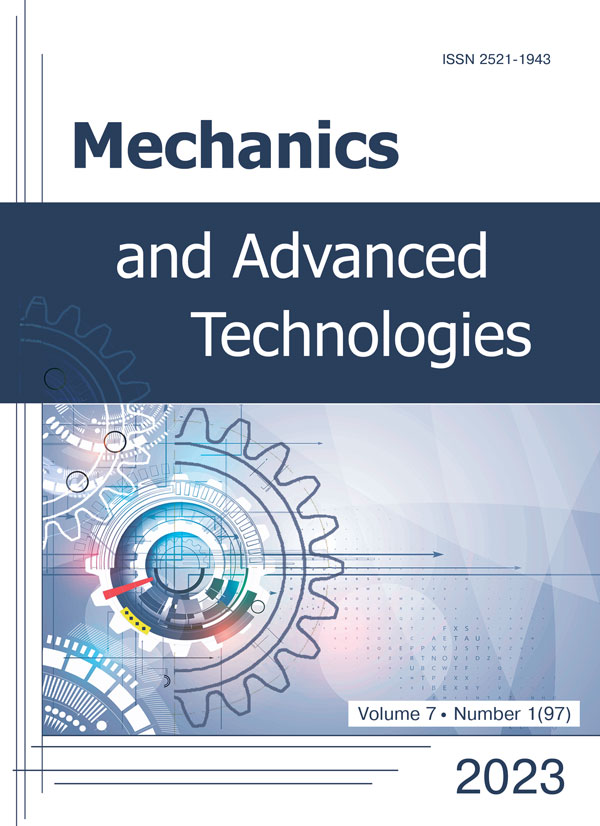Ensuring accuracy of contour milling on CNC machines
DOI:
https://doi.org/10.20535/2521-1943.2023.7.1.276162Keywords:
contour milling, correction of the control program, modeling of the contour millingAbstract
Contour milling is characterized by quasi-stationary, which leads to the occurrence of a machining error caused by elastic deflections of the machining system. Moreover, such an error cannot be eliminated by sub-adjusting the control program "for size", since it not is constant and changes along the contour in a wide range. To ensure the accuracy of contour milling, a new method of combined control is proposed, which uses a posteriori information of machine verification measurements of the machined surface and a priori information of modeling the material removal process. In case of single manufacturing, the allowance on the last pass is divided into two parts, and after machining the first part, verifications are performed, then modeling and machining of the second half according to the corrected control program. In mass manufacturing, verifications are performed on the first part, and all subsequent ones are machined according to the adjusted control program. To obtain the necessary a posteriori information, the technology of machine verifications on CNC-machine with a three-coordinate probe according to standard control programs is proposed, and it is enough to perform two measurements or one, in the presence of surfaces inclined to the coordinate axes of the contour. A computer program was created, the core of which is a mathematical model of the process, which reproduces the structural diagram of the machining system closed behind two elastic deflections. The primary control file is loaded in G-codes with measurement data, and as a result of the process simulation, a new control file for the CNC-machine tool is formed, which eliminates the error from elastic deflections of machining system. Preliminary tests showed the possibility of increasing the accuracy of contour machining by more than 3 times.
References
- J. Niu et al., “A short review on milling dynamics in low-stiffness cutting conditions”, Modeling and analysis Journal of Ad- vanced Manufacturing Science and Technology, No. 1, 2021. DOI: https://doi.org/10.51393/j.jamst.2020004
- Solid CAM. The Leaders in integrated CAM. Available: https://www.solidcam.com/ru/imachining/
- Y.V. Petrakov and А.V. Myhovych, “IMachining technology analysis for contour milling”, Mechanics and Advanced Technol- ogies, No. 2 (89), 2020. DOI: https://doi.org/10.20535/2521-1943.2020.89.202065
- Kris M. Y Law and A. Geddam, “Prediction of contour accuracy in the end milling of pockets”, Journal of Materials Processing Technology, Vol. 113, Issues 1–3, pp 399–405, 15 June 2001. DOI: https://doi.org/10.1016/S0924-0136(01)00594-5
- Xiong Han and Limin Tang, “Precise prediction of forces in milling circular corners”, International Journal of Machine Tools and Manufacture, Vol. 88, pp 184–193, January 2015. DOI: https://doi.org/10.1016/j.ijmachtools.2014.09.004
- Y. Yang et al., “Chatter prediction for the peripheral milling of thin-walled workpieces with curved surfaces”, International Journal of Machine Tools and Manufacture, Vol. 109, pp. 36–48, 2016. DOI: https://doi.org/10.1016/j.ijmachtools.2016.07.002
- T.L. Schmitz and B.P. Mann, “Closed-form solutions for surface location error in milling”, International Journal of Machine Tools & Manufacture, No. 46, pp. 1369–1377, 2006. DOI: https://doi.org/10.1016/j.ijmachtools.2005.10.007
- Y. Altintas, Manufacturing Automation. Metal Cutting Mechanics, Machine Tool Vibrations, and CNC Design, 2nd ed., Cam- bridge University Press, 2012. DOI: https://doi.org/10.1017/CBO9780511843723
- A. Jacso and T.Szalay, “Optimizing the numerical algorithm in Fast Constant Engagement Offsetting Method for generating 2.5D milling tool paths”, The International Journal of Advanced Manufacturing Technology, No. 108 pp. 2285–2300, 2020. DOI: https://doi.org/10.1007/s00170-020-05452-1
- Changqing Liu Yingguang Li Weiming Shen “A real time machining error compensation method based on dynamic features for cutting force induced elastic deformation in flank milling”, Machining Science and Technology An International Journal, Vol. 22, Issue 5, 2018. DOI: https://doi.org/10.1080/10910344.2017.1402933
- T.C. Bera, K.A. Desai and P.V.M. Rao, “Error compensation in flexible end milling of tubular geometries”, Journal of Materials Processing Technology, No. 211, pp. 24–34, 2011. DOI: https://doi.org/10.1016/j.jmatprotec.2010.08.013
- Y. Petrakov, V. Korenkov and A. Myhovych, “Technology for programming contour milling on a CNC machine”, Eastern-
- European Journal of Enterprise Technologies, No. 2 (1 (116)), pp. 55–61, 2022. DOI: https://doi.org/10.15587/1729-4061.2022.255389
- M. Schwenzer et al., “Continuous identification for mechanistic force models in milling”, IFAC-Papers On Line, Vol. 52, Issue 13, pp 1791–1796, 2019. DOI: https://doi.org/10.1016/j.ifacol.2019.11.461
- Renishaw. Inspection plus software for HAAS machining center Programming manual H-2000-6222-0A-B, 2008. Available: https://www.haascnc.com/content/dam/haascnc/en/service/manual/probe/english---renishaw-inspection-plus---programming-manual---2008.pdf
Downloads
Published
How to Cite
Issue
Section
License
Copyright (c) 2023 Юрій Володимирович Петраков, Юрій Романов

This work is licensed under a Creative Commons Attribution 4.0 International License.
Authors who publish with this journal agree to the following terms:
- Authors retain copyright and grant the journal right of first publication with the work simultaneously licensed under CC BY 4.0 that allows others to share the work with an acknowledgement of the work's authorship and initial publication in this journal.
- Authors are able to enter into separate, additional contractual arrangements for the non-exclusive distribution of the journal's published version of the work (e.g., post it to an institutional repository or publish it in a book), with an acknowledgement of its initial publication in this journal.
- Authors are permitted and encouraged to post their work online (e.g., in institutional repositories or on their website) prior to and during the submission process, as it can lead to productive exchanges, as well as earlier and greater citation of published work





